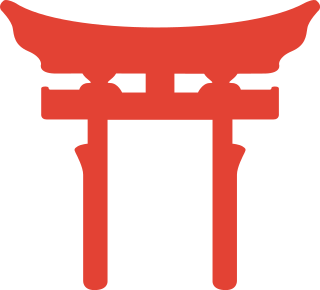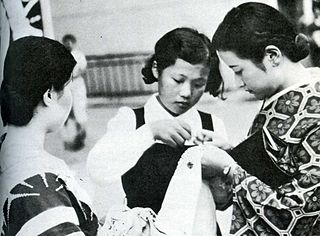 W
WBiwa hōshi (琵琶法師), also known as "lute priests", were travelling performers in the era of Japanese history preceding the Meiji period. They earned their income by reciting vocal literature to the accompaniment of biwa music. Often blind, they adopted the shaved heads and robes common to Buddhist monks. This occupation likely had its origin in China and India, where blind Buddhist lay-priest performers were once common.
 W
WIn Japan, Daikokuten (大黒天), the god of great darkness or blackness, or the god of five cereals, is one of the Seven Lucky Gods (Fukujin). Daikokuten evolved from the Buddhist form of the Indian deity Shiva, syncretized with the Shinto god Ōkuninushi under shinbutsu-shūgō. The name is the Japanese equivalent of Mahākāla, the Hindu name for Shiva.
 W
WDōsojin is a generic name for a type of Shinto kami popularly worshipped in Kantō and neighboring areas in Japan where, as tutelary deities of borders and paths, they are believed to protect travellers, pilgrims, villages, and individuals in "transitional stages" from epidemics and evil spirits. Also called Sae no kami or Sai no kami (障の神・塞の神), Dōrokujin (道陸神) or Shakujin . Dōsojin are often represented as a human couple, carved male or female genitals, large stones or statues, or even tall poles along a road.
 W
WEbisu , also transliterated Webisu or called Hiruko (蛭子) or Kotoshiro-nushi-no-kami (事代主神), is the Japanese god of fishermen and luck. He is one of the Seven Gods of Fortune , and the only one of the seven to originate purely from Japan without any Hindu influence.
 W
WEe ja nai ka (ええじゃないか) was a complex of carnivalesque religious celebrations and communal activities, often understood as social/political protests, which occurred in many parts of Japan from June 1867 to May 1868, at the end of the Edo period and the start of the Meiji Restoration. Particularly intense during the Boshin War and Bakumatsu, the movement originated in the Kansai region, near Kyoto.
 W
WInari Ōkami , also called Ō-Inari (大稲荷), is the Japanese kami of foxes, fertility, rice, tea and sake, of agriculture and industry, of general prosperity and worldly success, and one of the principal kami of Shinto. In earlier Japan, Inari was also the patron of swordsmiths and merchants. Represented as male, female, or androgynous, Inari is sometimes seen as a collective of three or five individual kami. Inari appears to have been worshipped since the founding of a shrine at Inari Mountain in 711 AD, although some scholars believe that worship started in the late 5th century.
 W
WItako , also known as ichiko (市子) or ogamisama (オガミサマ), are blind women who train to become spiritual mediums in Japan. Training involves severe ascetic practices, after which the woman is said to be able to communicate with Japanese Shinto spirits, kami, and the spirits of the dead. Itako perform rituals tied to communication with the dead and divination. The practice has been on the decline, with only 20 living itako in Japan, all more than 40 years old.
 W
WKōshin (庚申) or Kōshin-shinkō (庚申信仰) is a folk faith in Japan with Taoist origins, influenced by Shinto, Buddhism and other local beliefs. A typical event related to the faith is called Kōshin-kō (庚申講), held on the Kōshin days that occur every 60 days in accordance with the Chinese sexagenary cycle.
 W
WThe Maneki-neko is a common Japanese figurine which is often believed to bring good luck to the owner. In modern times, they are usually made of ceramic or plastic. The figurine depicts a cat, traditionally a calico Japanese Bobtail, with a paw raised in a Japanese beckoning gesture. The figurines are often displayed in shops, restaurants, pachinko parlors, dry cleaners, laundromats, bars, casinos, hotels, nightclubs, and other businesses, generally near the entrance. Some Maneki-neko are equipped with a mechanical paw which slowly moves back and forth.
 W
WA Senninbari or one thousand stitch is a belt or strip of cloth stitched 1000 times and given as an amulet by Japanese women to soldiers going away to war.
 W
WIn Japanese mythology, the Seven Lucky Gods or Seven Gods of Fortune are believed to grant good luck and are often represented in netsuke and in artworks. One of the seven (Jurōjin) is said to be based on an historical figure.
 W
WJapanese new religions are new religious movements established in Japan. In Japanese, they are called shinshūkyō (新宗教) or shinkō shūkyō (新興宗教). Japanese scholars classify all religious organizations founded since the middle of the 19th century as "new religions"; thus, the term refers to a great diversity and number of organizations. Most came into being in the mid-to-late twentieth century and are influenced by much older traditional religions including Buddhism, Shinto and Hinduism. Western influences include Christianity, the Bible and the writings of Nostradamus.
 W
WTaira no Masakado was a Heian period provincial magnate (gōzoku) and samurai based in eastern Japan, notable for leading the first recorded uprising against the central government in Kyoto.
 W
WIn Japanese folklore, the Takarabune (宝船), or "Treasure Ship", is a mythical ship piloted through the heavens by the Seven Lucky Gods during the first three days of the New Year. A picture of the ship forms an essential part of traditional Japanese New Year celebrations.
 W
WŌtoshi or Nigihayahi, commonly known: Toshigami or Ōtoshi is a Kami of the Shinto religion in Japan.
 W
WYakudoshi (厄年), or "calamitous years," are ages that in Japan are traditionally believed to be unlucky.
 W
WYama-no-Kami (山の神) is the name given to a kami of the mountains of the Shinto religion of Japan. These can be of two different types. The first type is a god of the mountains who is worshipped by hunters, woodcutters, and charcoal burners. The second is a god of agriculture who comes down from the mountains and is worshipped by farmers. This kami is generally considered as a goddess, or a female deity.